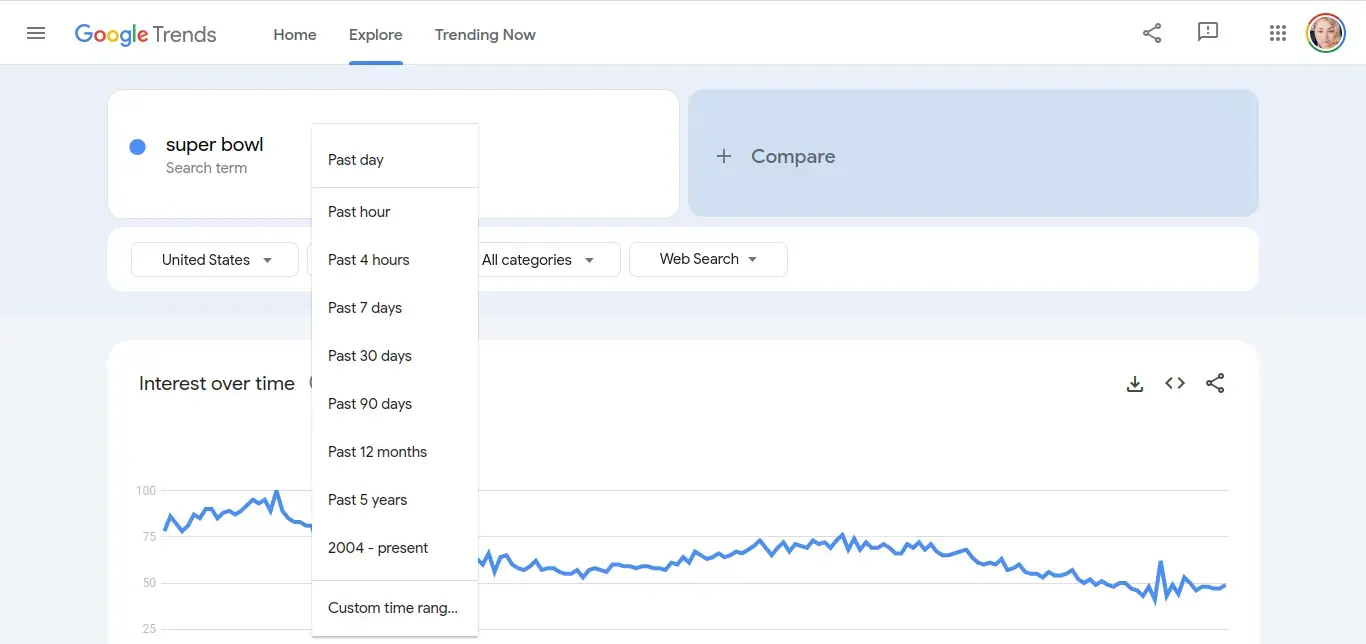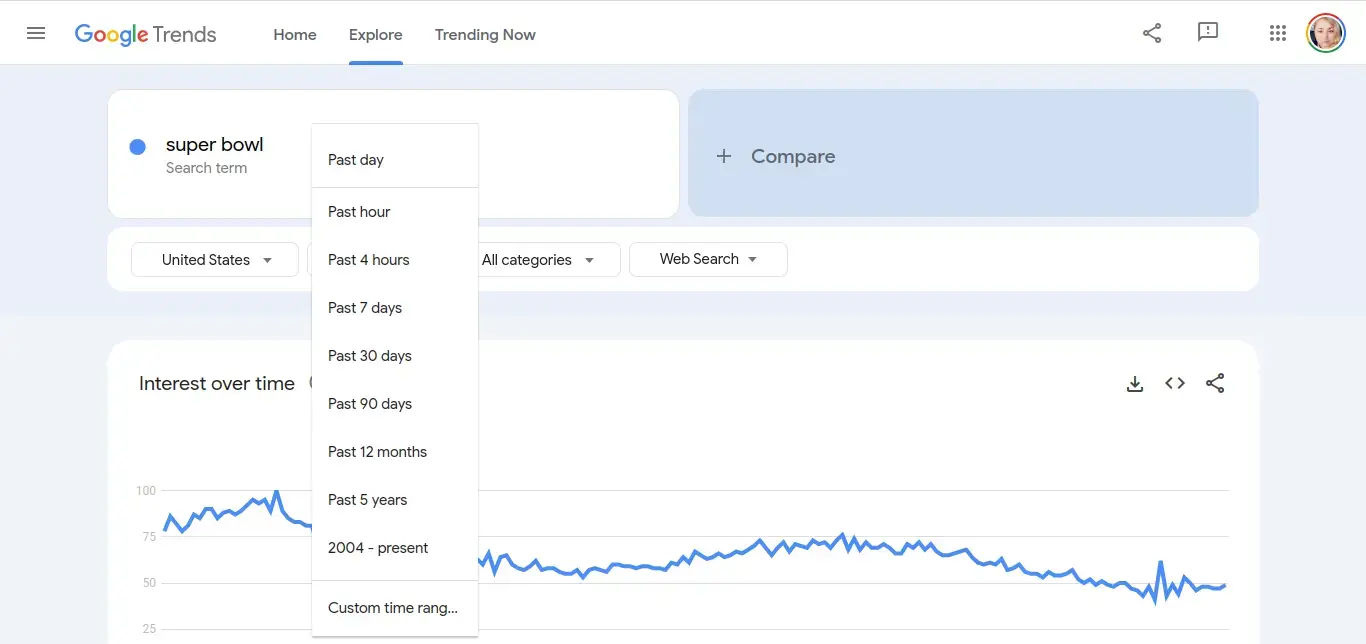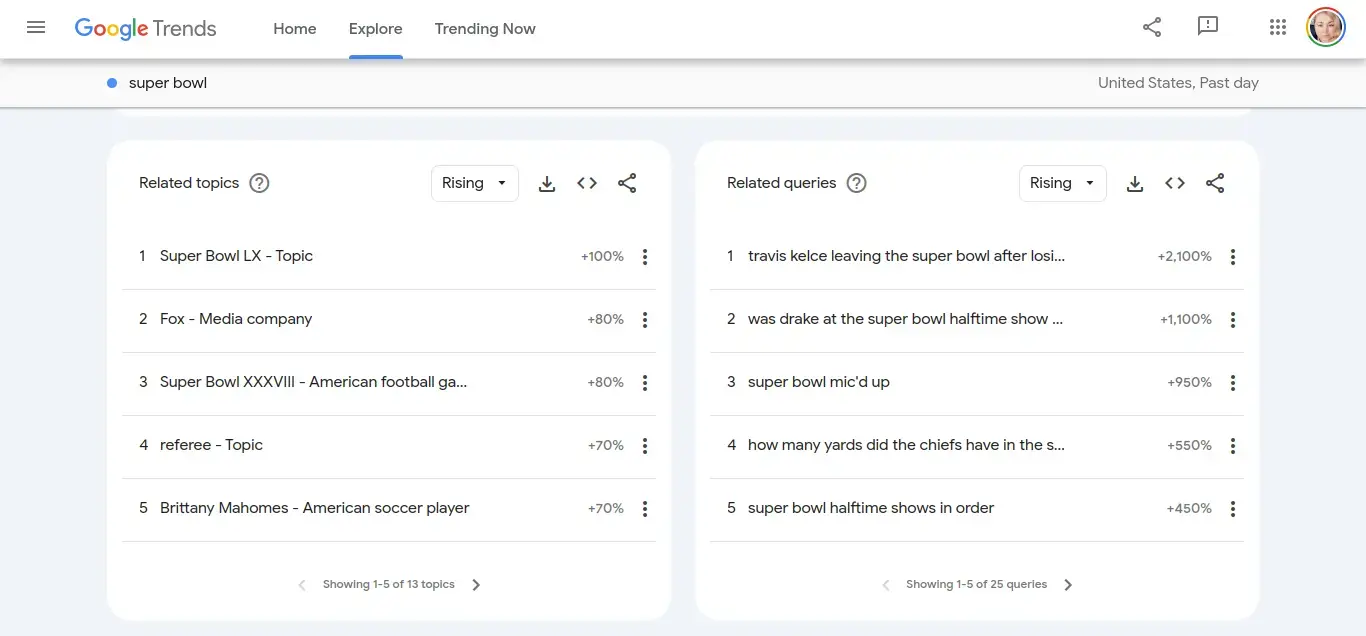If you like using tools to help generate more content ideas, Google Trends can help you do just that. Not only can you stay with trends, but also get an idea on what people actually are searching for. In This article, you’ll learn about this tool, but also how to use Google Trends for SEO in order to level up your content planning.
What is Google Trends?

Google Trends is a free website provided by Google that analyzes the popularity of search queries in Google Search across various regions and languages. It uses anonymized, aggregated data to show how often specific search terms have been entered into Google's search engine over a given period. To summarize, it gives you a glimpse into what the world is searching for, and how search interest in those topics changes over time.
At its core, Google Trends provides a relative measure of search volume. It doesn't tell you the absolute number of searches for a term. Instead, it normalizes the data to make comparisons between terms with vastly different search volumes easier. The data is presented on a scale from 0 to 100, where 100 represents the peak popularity for the term during the specified time range.
A value of 50 means that the term was half as popular at that time compared to its peak. A value of 0 means there was not enough data for this term. This relative scale is crucial because it allows you to compare the popularity of niche terms with very common ones without the massive search volume of the popular term overshadowing everything else.
Reasons to use Google Trends for Content Creation
Google Trends can be a powerful tool for content creation. Here are 7 detailed reasons why you should use it:
Discover Trending Topics
Conduct Keyword Research
Identify Seasonal Trends
Understand Audience Interests
Generate Content Ideas:
Monitor Brand Reputation
Compare Competitors
Discover Trending Topics
Google Trends allows you to see what topics are currently popular and gaining traction. This can help you identify trending subjects that your audience is interested in and create content that is relevant and timely. By capitalizing on trending topics, you can increase the visibility of your content and attract a wider audience.
Conduct Keyword Research
Google Trends can assist you in your keyword research by showing you the popularity of specific search terms. This can help you identify keywords that are frequently used by your target audience, allowing you to optimize your content for search engines and improve its visibility.
Identify Seasonal Trends
Many industries experience seasonal fluctuations in demand and interest. Google Trends can help you identify these seasonal trends, allowing you to plan your content calendar accordingly and create content that is relevant to specific times of the year.
Understand Audience Interests
Google Trends provides insights into the interests of your target audience. By analyzing search trends, you can gain a better understanding of what your audience is interested in and create content that caters to their specific needs and preferences.
Generate Content Ideas
Google Trends can be a valuable source of inspiration for content ideas. By exploring trending topics and related queries, you can discover new and interesting subjects to write about, ensuring that your content remains fresh and engaging.
Monitor Brand Reputation
Google Trends can be used to monitor the online reputation of your brand. By tracking search volume for your brand name and related terms, you can identify any negative trends or spikes in interest, allowing you to address any potential issues and maintain a positive brand image.
Compare Competitors
Google Trends allows you to compare the keyword search volume for different brands or topics. This can be useful for understanding how your brand compares to your competitors and identifying areas where you can improve your content strategy.
How to Use Google Trends for SEO
Using Google Trends effectively for SEO involves more than just glancing at a trending topic. It's about understanding the data, refining your searches, and applying the insights to your SEO strategy. Here's a breakdown of how to use Google Trends for SEO:
Keyword Research and Refinement
Content Strategy and Creation
Understanding Search Behavior and Trends
Competitive Analysis
Refining Your Google Trends Searches
Keyword Research and Refinement
- Identify Seed Keywords: Start with your core keywords related to your niche. Enter these into Google Trends.

- Explore Related Queries: Pay close attention to the "Related queries" section. This is a goldmine of information. You'll find related keywords, long-tail keywords, and even questions people are asking. These related queries often have lower competition than your seed keywords and can be great targets for content creation.

Refine Your Keywords: Use the related queries to refine your keyword list. Look for keywords with rising popularity or consistent search volume. Avoid keywords with declining popularity unless they are absolutely essential to your niche.
Compare Keyword Popularity: Compare the search volume of different keywords to see which ones are more popular. Don't just focus on the most popular keywords; consider a mix of high-volume and lower-competition keywords.
Identify Question Keywords: The "Related queries" section often reveals questions people are asking. These are perfect for creating content that answers specific user queries and can help you rank for featured snippets.
Content Strategy and Creation
Discover Trending Content Ideas: Use Google Trends to identify trending topics within your niche. This can give you ideas for creating timely and relevant content that will attract more traffic.
Validate Content Ideas: Before investing time in creating content, use Google Trends to validate your ideas. See if there's sufficient interest in the topic and if the trend is rising or stable.
Optimize Content for Target Keywords: Once you've identified your target keywords, use them naturally within your content, including in the title, headings, subheadings, and body text.
Create Content Around Related Queries: Use the related queries you found in your keyword research to create content that addresses specific user needs and questions. This can help you target a wider range of keywords and attract a more diverse audience.
Focus on Evergreen Content: While trending topics can be great for short-term traffic, focus on creating evergreen content that will remain relevant and valuable over time. Use Google Trends to identify topics with consistent search volume.
Understanding Search Behavior and Trends
Analyze Search Trends Over Time: Look at the historical search data for your target keywords to understand how search interest has changed over time. This can help you identify seasonal trends and plan your content calendar accordingly.
Identify Geographic Trends: Use Google Trends to see where your target keywords are most popular. This can help you tailor your content Understand User Intent: By analyzing the related queries and the context of the search trends, you can gain a better understanding of user intent. This will help you create content that meets the needs of your target audience.
Monitor Brand Mentions: Track search volume for your brand name and related terms to monitor brand mentions and identify any potential issues.
Competitive Analysis
Compare Keyword Performance: Compare the search volume for your target keywords with the search volume for your competitors' keywords. This can give you insights into their SEO strategy and help you identify opportunities to improve your own.
Identify Content Gaps: Analyze the related queries for your competitors' keywords to identify any content gaps that you can fill.
Track Competitor Trends: Monitor the search trends for your competitors' brands and products to see what's working for them and identify any emerging trends.
Refining Your Google Trends Searches
Use Specific Search Terms: Be as specific as possible with your search terms to get more relevant results.
Use Filters: Use the filters in Google Trends to narrow down your results by region, time range, category, and search type (web, image, news, shopping, YouTube).
Explore Different Time Ranges: Experiment with different time ranges to see how search interest has changed over time. Compare Multiple Terms: Use the compare feature to compare the search volume of multiple keywords or topics.
In Summary
By following these tips, you can effectively use Google Trends to improve your SEO strategy, create better content, and attract more traffic to your website. Remember that Google Trends is just one tool in your SEO arsenal. Combine it with other SEO tools and techniques for a more comprehensive approach.
Frequently Asked Questions
How much does it cost to advertise on Google?
The cost to advertise on Google varies widely depending on several factors, including the industry, competition for keywords, targeting options, and the type of ad campaign.
On average, the cost per click (CPC) for Google Ads ranges from $1 to $2 on the Google Search Network, but it can be higher in competitive industries like legal services, insurance, and finance
How can Google Trends help ecommerce stores in planning their seasonal campaigns?
Google Trends allows ecommerce sites to analyze the popularity of search queries across different times, providing insights into seasonal relevance and customer behaviour. By identifying trends for relevant keywords, online businesses can time their advertising campaigns and content marketing to align with peak interest periods, potentially attracting more sales and new customers.
How can analyzing market trends boost my business growth?
Analyzing market trends through data analytics enables businesses to identify shifts in consumer preferences and economic conditions. By utilizing data visualization and machine learning, companies can predict future market conditions, tailor marketing strategies, and adjust pricing strategies accordingly, securing a competitive edge.
How can I use Google Trends data to identify high-demand products to sell online?
Use Google Trends as a free tool to analyze the popularity of product searches over time. Look for trending ecommerce products with rising search volumes, indicating increasing consumer interest, which can guide you to choose high-demand products for your online business.

Nile Flores is a long time professional blogger, as well as WordPress website designer and developer from the St. Louis Metro East. Nile blogs at NileFlores.com, where she’s passionate about helping website owners, whether they’re small business owners or bloggers. She teaches about Blogging, Social Media, Search Engine Optimization, Website Design, and WordPress. Additionally, Nile loves to speak at WordCamps (WordPress conferences) across the United States. When Nile isn’t knee-deep in coding, she’s a proud mom of a college student, and enjoys oil painting, cigar smoking, nail art design, and practicing traditional Okinawan kempo karate.
View all posts by Nile Flores





















